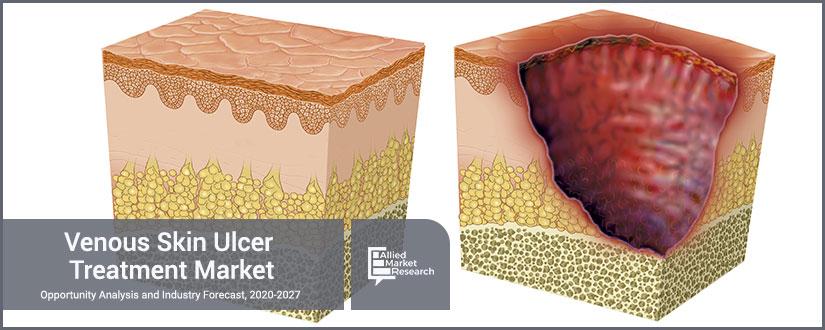Venous ulcers (open sores) usually occur when the veins in the individuals' legs do not push blood back up to his or her heart. Blood backs up in the veins and builds up the pressure. If not treated, raised pressure and excess fluid in the affected area, may cause an open sore to form. The most venous ulcers occur on the leg, which is above the ankle. The wound can be slow to heal. The main cause of venous ulcers is high pressure in the veins of the lower leg. Furthermore, the veins have one-way valves that can keep blood flowing up toward your heart. When the valves become weak, or the veins become scarred and also blocked, blood can flow backward and pool in your legs. Additionally, this is called venous insufficiency. The lack of nutrients causes cells to die, hence damaging the tissue, and a wound can form.
COVID-19 scenario analysis:
The pandemic caused due to Coronavirus disease 2019 (COVID-19) has led to global economic crisis, especially in the healthcare sector. The health care sector in the developing countries and low-income countries has been highly led to a downfall. The Covid-19 pandemic has negatively impacted the healthcare system, which caused 50% to 70% drop in revenue from March. There are several small hospitals, clinics and nursing homes, which have been forced to close their operations. Due to the social distancing and localized curfews there has been delay in elective surgical procedures. In addition, visa cancellations have led to a hiatus in medical tourism and can negatively impact the healthcare services market growth.
Top impacting factors: Market Scenario Analysis, Trends, Drivers and Impact Analysis
The major factor affecting the market includes the surge in the incidences of venous skin ulcers which would boost the industry in the forecast period. The rise in the awareness regarding the innovation in the dressings and the bio skin treatments available nowadays would help the market propel in the forecast period. The increase in the awareness of the presence of such disease is anticipated to help the market grow in the coming years.
New product advancements to flourish the market
In April 2016, BSN medical, the global integrated medical therapy provider, announced the launch of three new integrated therapeutic solutions focused on treating venous leg ulcers (VLUs), diabetic foot ulcers (DFUs) and postoperative surgical sites. In addition, these solutions are supported with the launch of two new wound care products, plus products featuring the company’s DACC Technology, a powerful alternative to silver antimicrobial dressings, and the JOBST brand of compression therapy.
In October 2019, PolarityTE, Inc., a biotechnology company developing and commercializing regenerative tissue products and biomaterials, today announced findings from an open-label, single-arm pilot study, which examined the impact of SkinTE, a novel human cellular and tissue-based product derived from a patient's own skin, in closing venous stasis leg ulcers (VLUs) following failure of conventional treatments.
Surge in Incidences of Venous Skin Ulcer to boost the market
According to the NHS it is estimated that 1 in every 50 people over age 80 would experience venous skin ulcer. Furthermore it is projected to affect about 1 in every 500 people in United Kingdom. Thus, Surge in incidences of venous skin ulcer will drive the market growth.
Key benefits of the report:
- This study presents the analytical depiction of the global Venous Skin Ulcer Treatment industry along with the current trends and future estimations to determine the imminent investment pockets.
- The report presents information related to key drivers, restraints, and opportunities along with detailed analysis of the global Venous Skin Ulcer Treatment market share.
- The current market is quantitatively analyzed to highlight the global Venous Skin Ulcer Treatment market growth scenario.
- Porter’s five forces analysis illustrates the potency of buyers & suppliers in the Venous Skin Ulcer Treatment market.
- The report provides a detailed global Venous Skin Ulcer Treatment market analysis based on competitive intensity and how the competition will take shape in coming years.
Questions answered in the Venous Skin Ulcer Treatment Market research report:
- Who are the leading market players active in the Venous Skin Ulcer Treatment market?
- What are the current trends will influence the market in the next few years?
- What are the driving factors, restraints, and opportunities in the market?
- What are the projections for the future that would help in tasking further strategic steps?
Venous Skin Ulcer Treatment Market Report Highlights
| Aspects | Details |
| By Product |
|
| By Stage of Disease |
|
| By End Users |
|
| By Region |
|
| Key Market Players | Cardinal Health, Smith & Nephew plc., Integra LifeSciences Corporation, Mölnlycke Health Care AB, PAUL HARTMANN AG, Bauerfeind, 3M, SIGVARIS, URGO Medical |
Loading Table Of Content...




